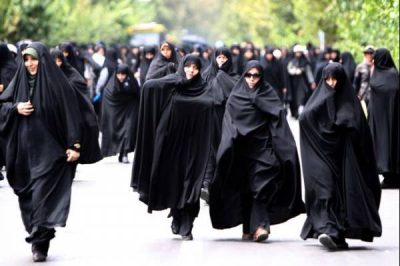By
Semra Dehamna
Muslim women stand out in the Western media as a tool employed to distort the image of Islam and Muslims, helping the interests of the huge media machine run under a Zionist influence with the objective providing distorted stereotypes of Muslim women.
In this article we feature the stereotypes of Muslim women in the Western media in order to identify its premise and cultural significance, and ask:
How credible is this image and representation of reality? What are the criteria from which the Western media provide this image?
In this context regarding the credibility of the image and standards that are based on it, I cite a review of an article by a researcher Arzu Mirali, head of research for the rights of Muslim women’s organization, published in the Guardian newspaper where it says: “Muslim women have become for journalists a Western model of underdevelopment and model persecution” and emphasizes that this grandiose and radical attack, which lacks objectivity, photographed those women victims of the so-called Islamic terrorism, and goes on to say: “The Muslim women in the eyes of these journalists must get rid of this debt, and when they get rid of it, will get rid of the veil that covered her from head to feet,” concludes the researcher in this editorial report that the ‘attack’ by the West in the media on Muslim women is not justified, and the fact that Western women suffer a lot of problems, and wonder why these are not directed at the West Bank to resolve women’s problems, rather than to criticize and attack Muslim women.
Through previous data reported by the researcher, which clearly lacks credibility and stereotypes, I will derive some of the criteria from which the media is addressing the issues of Muslim women, and what I believe to be the basis for the analysis of these stereotypes.
The first criterion: the call to lift the tutelage of religion and women:
It is seen that the most free in this respect touch the full infringement of Islam in order to veto a constitution, methodology and legislation, and to consider religion a stumbling block in the way of women’s progress. This coincides with a campaign that grew after the atheist ten events of September against the Koran and the Prophet Muhammad, peace be upon him and against rituals of Islam.
Examples are many in that media, including criticism by Ed Pilkington in the Guardian newspaper, referring to Balmichddh, which allows a man to marry four times, while this is not the case for women, criticizing the punishment for adultery and pointing out that prevention of expresses the erroneous doctrine practices and is not of Islam. Dissatisfaction was also expressed with men in respect of them mixing with young girls in the markets and public places.
Barbara Slavin also expressed in USA Today newspaper hope that the events of September be a reason to make clear cultural changes in the Kingdom, and for the Saudis to reconsider the issue of gender segregation and restrictions on women’s veils and travel without a mahram.
The above examples and many others all reveal the explicit call for the media in most of its paradigm to the cancellation of the debt of the Muslim woman’s life.
Almaaaralthani: lack of objectivity in the presentation of Muslim women’s issues:
It must be emphasized that most of what is offered from the investigations and articles about Muslim women does not exceed the concentration of cultural dependency and the fight against Islamic values.
Perhaps all of us have noticed channels like CNN and BBC News when the spotlight on the Taliban’s treatment of women in Afghanistan, where the focus of interest was in the cultural and social status of women linked to their religion, values and traditions, while celebrating women liberated from the veil after the Taliban. As for the American war producing bitter suffering in Afghanistan for millions of Afghan women and a harsh life heavy with fear, disease and hunger, spending the whole of winter in camps the equivalent of death camps, all this did not constitute the focus of attention of the Western media, and then, it dealt with the news in fleetingly .
We add another witness in this context, the radio speech of Mrs. Laura Bush, reported by CNN where she described the lives of women in Afghanistanas “Degrading. Children are not allowed to play kites, and women face punishment when laughing in a high voice and can not work outside the home, not even leave the house alone.”
We know that the first lady ‘s speech on Afghan women coincided with a US government report referred to as ‘the Taliban ‘s war against women’. The nine-page report is part of the battle against the Taliban.
We may wonder why human rights are employed by the Western media whenever it is wanted. Where are human rights when dealing with Afghan women’s issues? Where are the Palestinian women’s rights? Why not highlight their right to land and their right to security, and their right to live in dignity under the influence of the Israeli oppression and injustice? Why are Muslim women used as an input to the occupation, and when they are under occupation, this means ignoring the most basic physical rights to live a decent and safe life.
List these facts and see that the issue of rights in the Western perspective does not achieve cultural dependency and the elimination of Islamic values; do we find the Western media answering these questions?
One sign of a lack of objectivity is the selective approach in editing articles and investigations. These journalists often rely on a selective approach in choosing and documenting what is consistent, and in the case of proving the dissent conclude the article with the opinion of the investigation as a supporter of the Western model.
And it shows that the western selective approach is objective clearly in the Saudi case.When neglecting development results that have been achieved for women in the UK, the focus is primarily when talking about women’s abaya, without mentioning that this cloak did not prevent her from working in teaching, medicine, bank management, marketing, information technology, trade and others borne out by the reality of development in our country.
The third criterion: Method contempt and perception of inferiority:
Manifestations of contempt and perception of inferiority of the values of Islamic conservatism in some of what is reflected, and in this context consider what Nicholas Kristof said in The New York Times where he penned the term Black Ghosts, as Saudi women in the West stating: “If most Saudi women want to wear a tent, if they don’t want to drive, then that’s fine. But why not give them the choice? Why ban women drivers and why empower the religious police, the mutawwa, to scold those loose hussies who choose to show a patch of hair? If Saudi Arabians choose to kill their economic development and sacrifice international respect by clinging to the 15th century, if the women prefer to remain second-class citizens, then I suppose that’s their choice. But if anyone chooses to behave so foolishly, is it any surprise that outsiders point and jeer?”
In the context of our analysis a number of sarcastic images arise as examples, and we conclude that the Western media does not want to know about Muslim women, only black abayas. It described the black ghosts, using the word ‘Ninja’ and other descriptions and an emotionless disregard for other cultures and a contempt for its values, accusing them of obscurantism, ossification and stagnation.
Four: Consecration of the Western model for women and the model that invoked it:
This is one of the most important criteria, most notably, and I can assure you that the main objective of this means that all share in the presentation of duplicate stereotypes of Muslim women. The basis is almost devoid of an article or realization that women in the Muslim world are deprived of their freedom. In contrast, there is almost a consensus of Muslim women rejecting the Western model and warning of dire results while pushing forward.
And for us to review in this context a lengthy investigation in the Christian Science Monitor conducted by Nicole Janota with a number of Muslim women in Afghanistan, Iran and Saudi Arabia, asserted that all religion, culture and heritage formed their lives; and that if there were any problems surely the hijab was not one of them.
No wonder that this emphasizes the liberated women are proud of the nature of Islam and the status of women in it, especially since a group of Afghan doctors and teachers asserted that they would go after the Taliban and not let go of their hijabs, and that the provisions of Islam followed voluntarily by Afghan Muslims, both men and women, did not impose the ‘sword’ as portrayed by the Western media.
This enhances the aforementioned Nicholas Kristof interview in The New York Times that a number of Saudi women academics expressed their refusal of the stereotypical image that features Muslim women, where he says: “But Saudi women refuse and strongly stereotype that feature of Saudi women in the Western media” showing as one of the academics in adherence to the hijab, saying: “I cover my body and my face, and I am happy of being a religious girl obeying God’s rules,” and that: “You can not go to an Indian woman and say ‘why are you not wearing a sari?’ or to a western woman ‘why are you wearing a short dress?’ Well this is our abaya, this is part of my culture. It’s part of my tradition. It never bothered me.”
It is noteworthy that many Saudi women are in favor of this approach and assert that they are blessed with freedom, emancipated from sexual harassment, rape and watching their bodies used in the marketing of Coca-Cola, in addition to Western women being exploited to become a puppet of the man.
In this context Ed Pilkington confirms in the Guardian newspaper that most women in the UK choose to stay and continue these social customs which he cites the proverb: “The Saudi women will maintain their abaya and that if you come a million years from now you will find Saudi women preserving her abaya.”
Nicole Janota, editor at The Christian Science Monitor, with regard to Saudi Arabia, confirmed by an advisory, said: “You have to remember that most Muslim women want the veil, there is nothing but religion, the headscarf as a symbol of the faith, a form of protection; it’s not going to change like a second skin.”
In an interview with a charitable work leader in the UK at the Guidedones.com site, the imposition of the Western model for the Muslim woman is condemned: “The problem with other people, because they have a particular style of life and they think that if you did not live like them, there is something wrong with you, why are they calling for Muslim women in Saudi Arabia to wear the American or European way?” and rejects the common term in the Western media, saying: “what the West calls the suffering when talking about Muslim women we do not find it as well. The real suffering is evident when we compare between women and the women we have.” She cited statistics about rates of health and ethical problems of Western women, and he wondered if the Western women model is really worth anything?”
In this context, it condemns the Iranian publisher in The Christian Science Monitor with regard to Western interest in the headscarf and that this baffles many Muslims. He adds that “people from abroad when they see us they look only to a small part of us which is being veiled, they do not look at the largest women’s section which is being educated,” confirming that “women in Iran have more important issues than the abaya.”
A President of a Saudi charity in USA Today stated: “They say we are behind, but they do not see what is under the cloak, we do not want America to come and put demands on behalf of us, leave us alone.”
No wonder Nicole Janota in The Christian Science Monitor stated that “they want to develop, but the conditions and standards that fit their communities are demanding to stop Westerners from harassment and spin fantasies about who is not?”
And it stresses that concept from Edward Pilkington in the Guardian newspaper: “Yes, we want to evolve and change for the better, but do not want to lose our religion,” commented the journalist that Saudi women want to resolve their problems internally and by themselves do not want Western intervention.”
There was also a comment from one of the leaders of Women in the Arab world on the BBC News channel “that despite the thirst for change, however, most of the Arab women are true to conservative aspects in their communities.”
Nicole Janota, editor of The Christian Science Monitor said: “History gives Muslim women strong justification to doubt the intentions of Western countries. The European states always used Muslim women as a pretext to interfere in the affairs of Islamic countries for the purpose of occupation…and that the French donations for Algeria in the late nineteenth century stipulated oil and flour as provision for the poor wives of the veil.”
In this context, Mrs. Laura Bush coordinated the external call center for Middle Eastern Studies at Harvard University, asserting that “the radio speech about the abuse of women in Afghanistan accounts for the substantiall Western use of Muslim women as an excuse and reason to interfere in the internal affairs of Islamic countries, where before September 11th, there was no interest from the West to women of Afghanistan.”
Through previous data and to the extent we recognize the Western model of the Islamic world, we failed to decide that this failure is due to the methodology associated with the approach, and perceptions fake and imported are meant to convey without considering the validity and legitimacy.
To the extent that Muslim women are recognized to change and development can not be a transfer of the Western model for women, the fact that this model, alien to their culture, thought and conscience, and can not succeed and continue, is also aware that attempts to continue moving this model are in fact in progress.
It is however unfortunate that the Western media employs the culture of the West and is the general standard of progress and growth of civilization of nations, whatever their conscience, authority and social systems.
Five: Reference derived from the methodology and ideology of Western feminism, pivoting movement around the female:
This movement’s philosophy, methodology and legislation is inconsistent with the organization and laws of Islam and its values to the lives of Muslims.
We can observe those writing on Western feminist movements in the Muslim world in the adoption of the feminist agenda to eliminate the veil of Muslim women and change the personal status of Muslim family laws, and the embodiment of the issue of the battle of rights and conflict between men and women.
The truth is that we when we analyze, for example, the BBC News channel, we note the strong presence of this movement by editors who take it upon themselves to specialize in women of the Islamic world. It is a tribute to the birth of the National Council for Women in Egypt having the strength to enter new legislation to repeal Muslim personal status law, and pay tribute to the fact that the number of graduates of women in some Islamic countries more than men, denounce the Islamic veil and the attack on Islamic countries that separate the sexes in education and employment, to the glorification of Arab activists.
And not to mention descriptions launched by feminist thought in the Western media on Muslim women, from the professional, to second-class citizenship to other descriptions of inferiority, as well as the transfer of the image sincere in what has been achieved for women in Saudi Arabia in the fields of education and employment as a result of pressure developed by Saudi women in order to obtain their rights.
There is no doubt that Muslim women in general and women in Saudi Arabia in particular, took to reject Altgraybe, and is no longer the problem of women’s attire, Vhjabha becoming the title of her dignity, her education a way to reject Westernisation curriculum.
In this context, the Chairperson of the Committee on Culture and Heritage in the leading association in the Kingdom emphasizes in her interview at Guidedones.com that “these women have been emancipated to have a sense of arrogance and are moving out of the imagination, where they decide what the status of women in Saudi Arabia and the rest of the Muslim countries should be, by focusing on these countries” and that putting pressure on confirms that the problems of women in the UK are less compared to Western women, and cites statistics on AIDS and sexual diseases in Western societies between the percentage of women.
Six: Double standards in dealing with one issue:
Double standards of the things known widely in the Western media in dealing with the issues of Muslims in general, and in the affairs of Muslim women in particular, publicly contemplating ironically the double standards and the bias Western media show in dealing with the issues when it comes to Islam and Muslims while I received some from a US-friendly Muslim comments that said:
Why can you cover a nun from her head to her feet, and be respected in their eyes they are complying with the orders of the Lord, but when you do it is the Muslim practitioner.”
When a western woman sitting in her home takes care of the house and children, they are in their beautiful sacrifice for the sake of maintaining the affairs of the home, but when Muslim women do so they need to be liberated.
Why can the Jewish beard, seen as part of the right to practice one’s religion, and when they do it is a Muslim extremist.
When a Christian kills someone, religion is not mentioned, but when Muslim commits a crime, Islam is the one who is tried.
And why after all that, Islam is the religion it remains widespread and fastest growing in the world?
Conclusion: we should be aware of the dimensions of reality to target Muslim women, in particular this day represents a major part of the project the great powers and international bodies toward cultural and social change in the region.
Today we recognize that the goal of the Western media is the attenuation value of the Islamic civilization, and to enable Western values as to the openness and modernity of humanitarian and joint investigations and other terms, as we realize that the West with all its institutions will not rest only to export its values and culture, which is referred to God in saying: (you will not be satisfied with the Jews and the Christians until you follow their religion).
Today we recognize that what surrounds us of the latest developments requires us .. first to absorb the attack and understand its dimensions, secondly the foresight to deal with mechanisms, and third, the transformation of being open to the values of Western civilization and translating them into our lives to the position of exporting values and ethics of the West and what it represents these values to Salah and the integrity of the humanitarian response to the verse (Faint not nor grieve, you also incline if you are believers).





Semra, your article makes several critical and important points. Yes, the personification of Muslim women by some social media outlets accentuates a negative aspect of who they are. However, I would not automatically associate the media as a whole to be “run under a Zionist influence.” While stereotypical images may serve to undermine Islam and Muslims as a whole, these actions are not necessarily derived from religious organizations. I would argue that misconceptions of people, culture and religion are arrived at through factors such as ignorance and fear. The developed prejudices from factors such as ignorance and fear are sometimes exacerbated by depressed economic conditions which may serve the interests of political agendas. Recently (3.15.2016), Mina Sherzoy, profiled in Laura Bush’s book, We are Afghan Women, stated that “insecurity and corruption” hinder development in Afghanistan. She added “The frame of mind of Afghan women… is not the same as they were 14 years ago…Their dream is to be like everybody else…” Semra, are you familiar with this book? If so, what are your thoughts on Mina’s words?